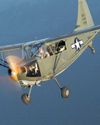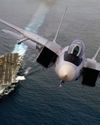कोशिश गोल्ड - मुक्त
Flying The FM-2 Wildcat
Flight Journal
|August 2019
A Modern Pilot’s Personal Perspective

I fully realize that the following dissertation on preflight, takeoff, cruise, and landing will be seen by experienced pilots as monotonous overkill—and too much detail. My thought here, however, is explain the airplane to the non-warbird pilot, paying special attention to the detail freaks, and to show the complexities and idiosyncrasies of even the simplest of World War II fighters. Note that the following is based on an FM-2 Wildcat with the original Bakelite brakes and a hard rubber carrier tailwheel. After about 50 hours, we exchanged the original brake shoes for heavy-duty truck lining and found a pneumatic tailwheel. These two things vastly improved ground handling.
This aircraft was not designed for speed (47% power = 564hp, 27 inches/1,900rpm = 195mph; and 80% power = 960hp, 35 inches/2,300rpm = 215 mph). The wing design does give good lift, so plus or minus 2 or 3mph will result in the need for a trim change, both pitch and yaw. I have spent many cross-country hours entertaining myself by trying to trim the Wildcat to fly hands-off. This aircraft has very light elevator forces, however, and the ailerons are heavy and will require two hands to roll at more than 200mph. The rudder is effective throughout the speed range, but the forces are heavy. One thing I must say about the Wildcat is that no fighter, then or now, will turn inside of it. Its overall flight characteristics are straightforward and benign. In flight, it handles much like a 1,350hp AT-6/SNJ.
Prestart Checks
यह कहानी Flight Journal के August 2019 संस्करण से ली गई है।
हजारों चुनिंदा प्रीमियम कहानियों और 10,000 से अधिक पत्रिकाओं और समाचार पत्रों तक पहुंचने के लिए मैगज़्टर गोल्ड की सदस्यता लें।
क्या आप पहले से ही ग्राहक हैं? साइन इन करें
Flight Journal से और कहानियाँ

Flight Journal
ELLIPTICAL ELEGANCE
Flying and evaluating the Seafire Mark III
4 mins
November - December 2025

Flight Journal
IRON DOG
Fighting the Pacific and the P-39 at the same time
14 mins
November - December 2025

Flight Journal
Fighter Pilots: A Warrior Clan
TAKE A HARD LOOK at the two young men in these photos. Do they look as if they were bent on killing one another? On the left we have a young, unknown enlisted Japanese pilot standing in front of a Nakajima Ki-27 \"Nate,\" one of Japan's earliest monoplanes that led to the much vaunted Zero.
3 mins
November - December 2025

Flight Journal
KEN WALSH THE FIRST CORSAIR ACE
Medal of Honor pilot's combat adventures
12 mins
November - December 2025

Flight Journal
Big Chief's Little Chief
Thunderbolt action with the Wolf Pack
11 mins
November - December 2025

Flight Journal
ENEMY PILOTS SPEAK Voices from the other side
All too often American students of air warfare forget that enemy aircraftwhether Messerschmitts or MiGs-were flown by human beings with the same motivations and traits as Allied airmen. More often than not, the only difference between friend and foe was the paint on the airplane and where they landed. Therefore, we've assembled a variety of accounts from WW II Axis fighter pilots, men who were more than simply targets.
11 mins
November - December 2025

Flight Journal
FLYING THE FW 190
A legend gets checked out in the Butcher Bird
15 mins
November - December 2025

Flight Journal
DOUBLE-THEATER ACE
The fearless missions of legendary fighter pilot Col. John D. Landers
12 mins
November - December 2025

Flight Journal
WARBUG IN THE PACIFIC
Surviving combat in a Stinson OY-1/L-5
10 mins
September - October 2025

Flight Journal
WINGS OF THE FLEET
Celebrating the U.S. Navy's 250-year legacy
9 mins
September - October 2025
Translate
Change font size

